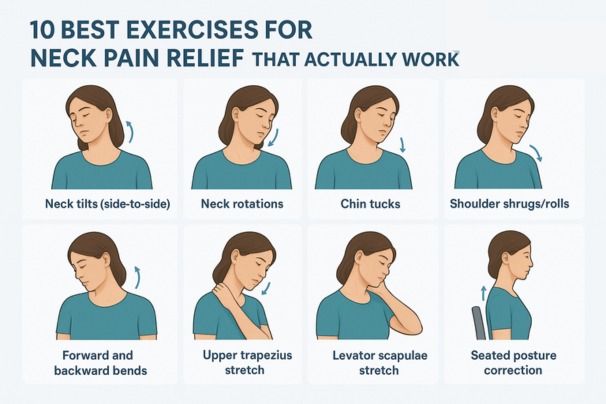
If you’re reading this while rubbing your neck or shifting in your chair, you’re not alone. Neck pain has become one of the most common musculoskeletal complaints worldwide. The World Health Organization (WHO) recognizes neck pain as a major contributor to disability, and research published in The Lancet ranks it among the leading causes of years lived with disability (YLDs) globally.
In India, neck pain is especially prevalent among office professionals, IT employees, call-center workers, students, and homemakers who spend long hours in front of screens or doing repetitive tasks. According to an ICMR (Indian Council of Medical Research) report, nearly 30–35% of working professionals in urban India report chronic or recurring neck pain, often linked to poor posture and prolonged sitting.
The good news is that regular exercise and stretching can significantly reduce neck pain, improve flexibility, and restore spinal health. Unlike painkillers, which only mask symptoms, exercise addresses the root cause — muscle weakness, poor posture, and joint stiffness.
In this article, we’ll explore 10 best exercises for neck pain relief that are:
- Backed by science
- Easy to perform at home or in the office
- Safe for most people when done correctly
We’ll also look at posture tips, lifestyle habits, and when to seek medical help.
Why Exercise Helps with Neck Pain
Before we dive into the exercises, let’s understand why movement is medicine for neck pain.
- Improves blood circulation → Supplies oxygen and nutrients to tight muscles and stiff joints.
- Releases muscle tension → Reduces stiffness caused by prolonged screen time.
- Strengthens stabilizer muscles → Supports cervical vertebrae and prevents future strain.
- Enhances posture → Counteracts forward head posture (common with phone/laptop use).
- Reduces nerve compression → By keeping discs and joints flexible.
A study published in the Journal of Orthopaedic & Sports Physical Therapy (JOSPT) found that targeted neck exercises combined with postural correction significantly reduced chronic neck pain within 6 weeks.
The 10 Best Exercises for Neck Pain Relief
Below are 10 proven, easy-to-do exercises. Each is explained with step-by-step instructions, benefits, and safety notes.
1. Neck Side-to-Side Stretch (Lateral Flexion)
How to do it:
- Sit or stand upright with shoulders relaxed.
- Slowly tilt your head to the right, bringing your ear closer to your shoulder.
- Hold for 20–30 seconds, feeling the stretch along the opposite side of the neck.
- Return to center and repeat on the other side.
- Perform 3–5 repetitions per side.
Benefits:
- Stretches the upper trapezius and scalene muscles, which are commonly tight in desk workers.
- Relieves stiffness from prolonged sitting.
Scientific note:
A workplace trial in Sweden (2016) showed that simple side flexion stretches performed thrice daily reduced reported neck discomfort among office staff by 35%.
2. Neck Rotation (Side-to-Side Turns)
How to do it:
- Sit tall with chin level.
- Slowly turn your head to the right as if looking over your shoulder.
- Hold 20 seconds.
- Return to center and repeat left side.
- Do 5–6 repetitions each side.
Benefits:
- Improves cervical spine mobility.
- Helpful for drivers, bikers, or anyone with difficulty turning the head.
Tip: Move slowly; avoid jerky motions.
3. Chin Tucks (Cervical Retractions)
How to do it:
- Sit upright with your back supported.
- Gently pull your chin straight back, creating a “double chin” effect.
- Hold 5 seconds, then relax.
- Repeat 10–12 times.
Benefits:
- Strengthens deep neck flexor muscles.
- Corrects forward head posture caused by mobile/laptop use.
- Reduces disc pressure on cervical spine.
Evidence:
Endorsed by the American Physical Therapy Association (APTA) as one of the most effective posture-correcting exercises.
4. Shoulder Rolls
How to do it:
- Sit or stand tall.
- Lift shoulders upward, roll them backward, then drop down.
- Perform 10–15 rolls.
- Repeat rolling forward as well.
Benefits:
- Relieves tension in the upper trapezius and rhomboids.
- Improves shoulder-neck coordination.
Pro tip: Pair with deep breathing for added stress relief.
5. Levator Scapulae Stretch
How to do it:
- Sit tall. Place right hand behind your head.
- Tilt head down and to the left, like looking into your armpit.
- Hold 20–30 seconds.
- Repeat on other side.
Benefits:
- Stretches the levator scapulae muscle, often strained by phone cradling or hunching.
Evidence:
A physiotherapy study in Manual Therapy Journal found levator scapulae stretching reduced pain intensity in office workers by up to 40% in 4 weeks.
6. Upper Trapezius Stretch
How to do it:
- Sit on a chair, holding the edge with your right hand.
- Tilt head to the left, bringing ear toward shoulder.
- Gently apply pressure with left hand on the head.
- Hold 20–30 seconds. Repeat other side.
Benefits:
- Releases tightness in trapezius, a common stress-related muscle.
- Reduces tension headaches linked to neck strain.
7. Cat-Cow Stretch (Yoga for Spine & Neck)
How to do it:
- Get on all fours, hands under shoulders, knees under hips.
- Inhale → arch your back, lift head & chest (cow pose).
- Exhale → round spine, tuck chin to chest (cat pose).
- Repeat 8–10 times.
Benefits:
- Mobilizes entire spine, including cervical region.
- Relieves stiffness in neck and shoulders.
Evidence:
Yoga-based stretches like Cat-Cow are proven in multiple RCTs to reduce musculoskeletal pain.
8. Wall Angels
How to do it:
- Stand with back flat against wall, arms at 90°.
- Slowly raise arms overhead while keeping elbows/wrists against wall.
- Lower back down.
- Repeat 10–12 times.
Benefits:
- Strengthens postural muscles (rhomboids, rear deltoids).
- Corrects rounded shoulders and forward neck posture.
9. Isometric Neck Strengthening
How to do it:
- Place palm on forehead, gently push head into palm (without moving).
- Hold 5 seconds.
- Repeat with palm on back of head, then sides.
- Do 5–8 repetitions per direction.
Benefits:
- Strengthens stabilizing muscles.
- Safe for those with limited mobility, as no actual neck movement occurs.
10. Thoracic Extension Stretch
How to do it:
- Sit on a chair with firm backrest up to mid-back.
- Place hands behind head, arch backward gently.
- Hold 10–15 seconds.
- Repeat 5–8 times.
Benefits:
- Restores thoracic mobility.
- Reduces compensatory strain on cervical spine.
Putting It Together: A Sample Neck Relief Routine
Here’s a 10-minute daily routine combining the above:
- Side-to-side stretch – 30 sec each side
- Chin tucks – 10 reps
- Neck rotation – 5 reps each side
- Shoulder rolls – 15 reps
- Levator scapulae stretch – 20 sec each side
- Cat-Cow stretch – 8 reps
- Wall angels – 10 reps
- Isometric strengthening – 5 reps per direction
- Upper trapezius stretch – 20 sec each side
- Thoracic extension – 5 reps
Done in 10–12 minutes, this routine can be performed at your desk, during a break, or at home.
Additional Lifestyle & Ergonomic Tips
1. Screen & Device Use
- Keep screens at eye level.
- Avoid cradling phone between ear and shoulder.
- Follow the 20-20-20 rule for eye & neck strain.
2. Ergonomic Workspace
- Use a supportive chair with lumbar and cervical support.
- Keep feet flat, knees at 90°.
- Keyboard & mouse at elbow level.
3. Daily Habits
- Stay hydrated (discs need water for cushioning).
- Take a 2–3 min standing/stretching break every 30 mins.
- Sleep with supportive pillow (avoid very high or flat pillows).
When to Seek Medical Help
While exercises are safe for most, see a doctor or physiotherapist if you notice:
- Pain persisting beyond 2–3 weeks.
- Numbness, tingling, or weakness in arms/hands.
- Headaches that worsen with neck movement.
- Loss of balance or coordination.
The Role of Physiotherapy & Specialists
Research from Harvard Health and Mayo Clinic highlights that physiotherapy is often the first-line treatment for chronic neck pain, along with posture training and lifestyle modification.
At We Are Spine, the approach is evidence-based: careful evaluation, guided exercise therapy, ergonomic correction, and — if necessary — interventional treatments. Early assessment helps prevent minor stiffness from developing into more complex cervical issues.

Conclusion
Neck pain is no longer an “age-related” issue; it’s a lifestyle problem affecting younger adults, students, and professionals alike. The exercises listed here are simple yet powerful tools to relieve pain, correct posture, and protect your cervical spine.
The key is consistency. A few minutes daily can make a huge difference in long-term spine health. And remember: if your symptoms persist, consulting a specialist ensures safe, targeted care.